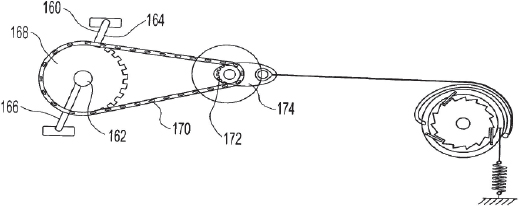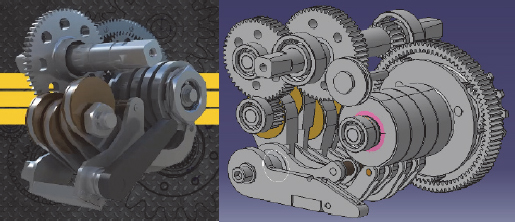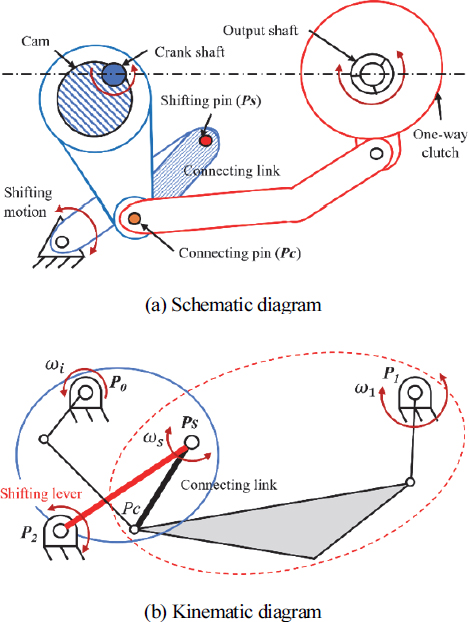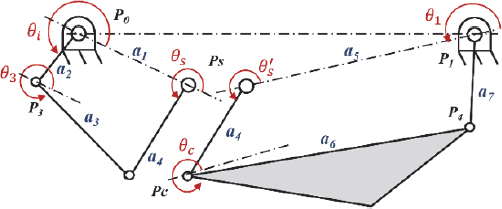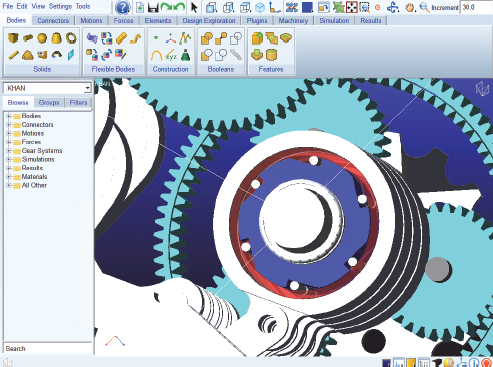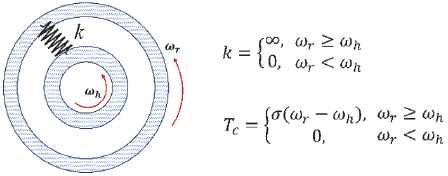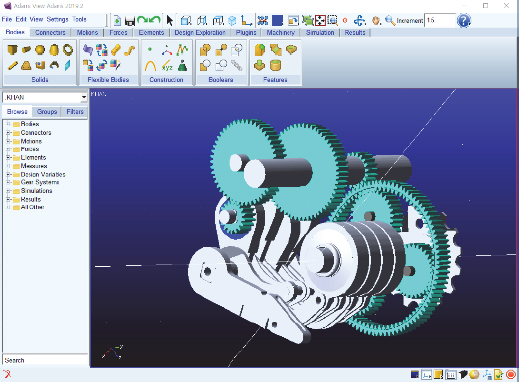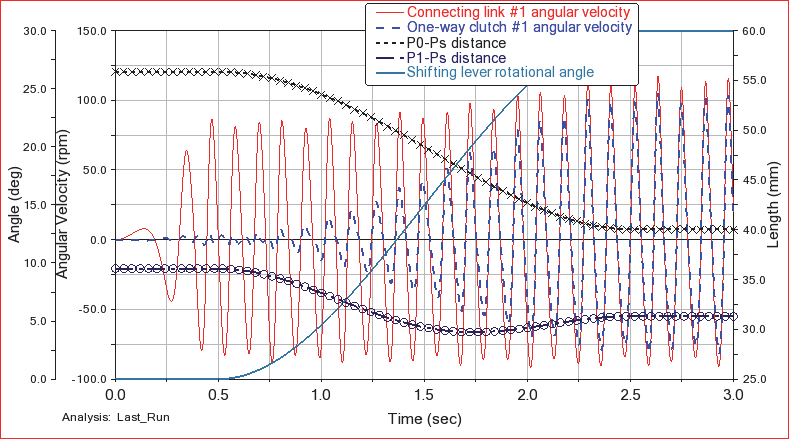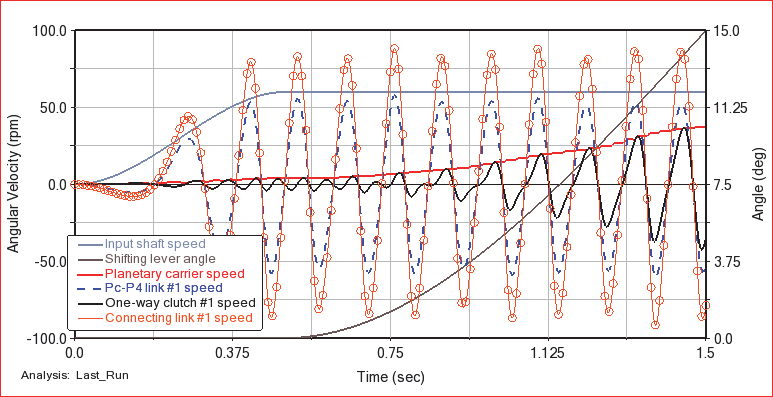
Analysis on the Shifting Mechanism of the Multi-link CVT
Copyright Ⓒ 2023 KSAE / 216-09
This is an Open-Access article distributed under the terms of the Creative Commons Attribution Non-Commercial License(http://creativecommons.org/licenses/by-nc/3.0) which permits unrestricted non-commercial use, distribution, and reproduction in any medium provided the original work is properly cited.
Abstract
In this paper, the shifting mechanism of Khan Workholding’s continuously variable transmission(Khan CVT) has been simulated by using ADAMS, a multi-body dynamics analysis software. Khan CVT is composed of an input module of a crank structure, a shifting module of four pairs of two four-bar mechanisms, and an output module consisting of four one-way clutches and a simple planetary gear. It is designed to be compact and lightweight. Input power drives the first four-bar loop, and the output shaft is driven by the four one-way clutches that are connected to the second loop. Since one rotation of the crank shaft leads to a reciprocating motion of each pair of multi-links, the number of strokes of one-way clutches is determined by input speed. To determine the shifting mechanism, a detailed kinematic analysis was performed. Speed relations for the repetitive motions of each four-bar loop due to changes in link length have been derived by using a complete geometric description of the two four-bar mechanisms. Based on the CAD model, a numerical model has been built by using ADAMS that can simulate the shifting mechanism and performance of the Khan CVT. Finally, the speed and torque relations of each component derived in the kinematic analysis were investigated.
Keywords:
Shifting mechanism, Multi-link continuously variable transmission, Four-bar mechanism, One-way clutch, ADAMS1. Introduction
Electrifications of the mobility are considered as one of the solutions for relieving exhaust gases and traffics, their commercialization has been accomplished through all over the related industry. Meanwhile personal mobility has been introduced as a solution for transportation that can run short or intermediate distances using electricity or oil as a power source. Moreover, it has also evolved into such a simple new motorized wheel as a form of public care for elderly and disabled people.
Considering that personal mobility particularly uses a small-sized power source, it is difficult to enhance their fuel economy and power performance simultaneously. And though its main speed range is low, there happen accelerating and decelerating drives more frequently than common vehicles, owing to its typical close-range uses. Thus, it is effective to enhance its driving performance by using a small transmission with many gear steps in its power flow for considering the small power source and various driving conditions of personal mobility vehicles.
Continuously variable transmissions(CVT) have been the object of considerable research interest within the mechanical design community, driven primarily by automotive applications. Unlike conventional stepped transmissions, a CVT allows for a continuous range of gear ratios that can, up to certain device-dependent physical limits, be selected independently of the applied torque. Existing CVTs can be classified into four types: belt drive, hydro-static/dynamic drive, traction/friction drive, and multi-link drive.
Among them, a multi-link drive is usually made with one-way clutches and crank-like devices that can adjust the crank arm length. The rotational motion of the drive shaft transforms into translational motion, and the one-way clutch rectifies the motion into a unidirectional motion; it is also called a ratcheting drive. Up to now, one of the main limitations of multi-link CVTs has been their propensity for producing a nonuniform output for a uniform input;1-5) therefore, their applications have been limited, but there are several examples of such transmissions.
Because of its unique power transmission mechanisms, multi-link drives do not exhibit the typical loss mechanisms of other CVTs. For instance, the frictional elements that transmit power in all multi-link CVTs are of the diode type. That is, they are either locked or freewheeling, and when transmitting power in the locked state they do so with no losses because there is no relative motion between components. The losses during freewheeling are also relatively small and independent of the transmitted power. Therefore, large rolling frictional losses and viscous slipping losses are avoided. Secondly, the clamping forces necessary to generate the friction are self-contained within commercially available sprag clutches. This keeps manufacturing costs and weight to a minimum. In addition, the shifting mechanisms can be designed to shift only the unloaded side of the drive, the particular mechanism, which is freewheeling at that instant. Therefore, the inefficient and complex shifting mechanisms of belt drives can be avoided.6)
While multi-link CVTs avoid the common sources of inefficiencies, the limited amount of available research references and commercially available examples can in part be attributed to the nearly universal trait of these transmissions, their non-uniform output for a uniform input. That is, given a constant input velocity, the output of most ratcheting drives will exhibit some sort of rippling effect. Up to now, this limitation has relegated these drives to vibration-tolerant applications only, such as farm equipment.
This paper deals with the dynamic behavior of the novel transmission focused on the shifting mechanism analysis. First, the overall structure and operating principles of Khan CVT are described in detail. The main part for implementing the shifting function is the multi-link module, which is composed of four pairs of two four-bar loops. In addition to finding out the shifting mechanism, a detailed kinematic analysis has been performed. Speed relations for repetitive motions of each four-bar loop due to changes in link length have been derived by using a complete geometric description of the two four-bar mechanisms. Based on the CAD model, a numerical model has been built using ADAMS which can simulate the shifting mechanism and performance of Khan CVT. The speed and torque relations of each component derived in the kinematic analysis have been investigated.
2. Operating Principles of a Multi-link CVT
2.1 Kinematic Synthesis of Multi-link CVTs
One of the multi-link CVT designs, Beale(2006) introduced a novel design shown in Fig. 1.7) It requires no outside system control to adjust the speed ratio. The effective speed ratio of the mechanism varies with the torque demand on the output shaft for a given input speed from 1:1 to nearly 1:0, as it scales output torque inversely to output speed.
The multi-link CVT design addressed here uses a Grashof four-bar crank rocker(or any analog thereto) with one-way clutches. Effectively, the crank-rocker mechanism behaves as a torque multiplier. It is used in many different applications to multiply the torque or force output of an otherwise incapable power source at the expense of speed, such as in oil horsehead pumps. Similar in concept to Beale, but different in implementation, is a design used by Matsumoto5) which is commercially available under the name “Zero-Max”.8) And Khan workholding(http://www.khanchuck.com) has revealed “Khan CVT”, which can manipulate the speed ratio with a novel lever mechanism, anticipating its application for personal mobilities such as an electric bicycle(Fig. 2).10) These transmissions use several reciprocating four-bar mechanisms to oscillate the one-way clutches.
2.2 Shifting Mechanism of a Multi-link CVT
In Khan CVT, there is a multi-link module composed of four pairs of two four-bar mechanisms. Each pair has the same components shown in Fig. 3. And there four cams, which convert the rotations of the crank shaft to eccentric oscillations, are installed at different angles on the crank shaft in the multi-link module. The two four-bar loops share the connecting link, which is connected by the connecting pin(PC) and the shifting pin(PS) in Fig. 3(a). The connecting pin is used to tie two four-bar loops within each multi-link pair respectively. However, the shifting pin interlinks the four pairs; the shifting motion moves each end of the connecting links at the same amount.
In Fig. 3(b), input power is applied to the crank shaft on the left which oscillates the first four-bar mechanism (crank-rocker). Then the second loop(rocker-rocker) converts these oscillations to a continuous output rotation through four one-way clutches. While the connecting pin moves along with the link connected to the crank shaft, the shifting pin can move and/or hold its position by shifting lever.
The shifting of Khan CVT is made by rotating the shifting lever, in which one end is fixed in the CVT housing and the other is connected to the shifting pin. Rotation of the shifting lever(δα) moves the shifting pin; it changes both the distances of PS from P0(the center of crank shaft) of the first four-bar mechanism and from P1(the center of one-way clutch) of the second(see Fig. 4).
After the shifting lever rotates, the distance of P'S from P0 (P0P'S) can be obtained by applying the second law of Cosines for the triangle ΔP0P2P'S as follows:
| (1) |
where, lS is the length of shifting lever, l0 the fixed distance of P0 from P2, β denotes the fixed angle of ∠P0P2P1, and α the prior angle of ∠PSP2P1 respectively. Similarly, the distance of Ps from P1 (P1P'S) in ΔP1P2P's becomes
| (2) |
where, l1 is the fixed distance of P1 from P2.
Since the length of the P0P'S link(solid lines) in the first loop becomes different from the prior configuration(P0PS in dashed lines), then it changes the rocking speed of connecting link(ωS), which is the driver for the second loop. The length of the P1P'S link also changes in the same way. As a result, the reciprocating speed of the follower(ω1), i.e., the one-way clutches, in the second four-bar mechanism varies according to the shifting angle change.
The gear ratio of the multi-link module is defined as the ratio of the rotational speed of crank shaft(ωi) in the first four-bar loop over that of one-way clutch(ω1) in the second. Since each one-way clutch rotates the output shaft equally by the number of one-way clutches, one can assume the speed of each clutch as the same value. There have been a number of theoretical and numerical results on the kinematics of four-bar mechanisms, and the related equations are well described in many literatures.9) Omitting the complicated derivation, the gear ratio ρ can be expressed by using the relevant angles and the lengths depicted in Fig. 5 as follows:
| (3) |
Summarizing the shifting mechanism, the rocking speed of the connecting link varies the lengths of base links in the four-bar loops, owing to the rotation of the shifting lever. Then, it makes the rocking speed of each one-way clutch change finally.
3. Dynamic Modeling of a Multi-link CVT
3.1 One-way Clutch Model
Khan CVT here has four roller type one-way clutches in the output sprocket module(see Fig. 6). One-way clutch is a device in which two rotating elements(hub and ring) can be free-wheeled or locked depending on the relative speed. According to the locking mechanism, they are typically classified into sprag and roller types. When the clutch is locked, the torque is transmitted exactly as the input value, otherwise the torque is not transmitted kinematically.
Note that input power drives the first four-bar loop, and the output shaft is driven by the four one-way clutches connected with the second loop. The number of strokes per minute of a clutch is the follower’s rocking speed of the second loop(ω1 in Fig. 3). Since one rotation of the crank shaft causes one reciprocating motion of each pair of multi-links, it is readily apparent that the number of strokes of one-way clutches is determined by the input speed(see Fig. 3(a)). However it is difficult to model the discontinuity of power transmission in a one-way clutch numerically; the equivalent stiffness k between the hub and ring should have an infinite value when they are locked. Thus, the clutch torque is assumed by using the torque constant σ, which is determined by the values of input torque and relative speed in this study as Fig. 7.
3.2 ADAMS Multibody Dynamic Model
Based on the 3-dimensional CAD model of Khan CVT, a numerical simulation model has been built using ADAMS software, a multibody dynamics simulation solution(Fig. 8). ADAMS(Automated Dynamic Analysis of Mechanical Systems) is a multibody dynamics simulation software equipped with Fortran and C++ numerical solvers. The moving parts such as gears, clutches, and links are connected with each other via corresponding joints. The parameters necessary for the dynamic simulation, e.g., contact and solver, are assumed as the default values in ADAMS.
There are three modules in its power transmission: input crank, multi-link, and output sprocket module in order. The completed dynamic model consists of a total of 40 parts, and each component is connected by 22 revolute joints and 9 fixed joints. Finally, the degrees of freedom of Khan CVT model are 74.
The input crank module consists of two idle gears between the input and crank shaft, it is a gear ratio of 0.114. Moreover, input shaft is connected to the ring gear in the output sprocket module with reduction gear ratio of 91/20. The output sprocket module of Khan CVT has a simple planetary gear, which its number of teeth ratio(λ) for ring over sun gear is 82/20. Its sun gear is connected to the sprocket of output shaft, and the ring gear is to the input shaft as stated earlier. The carrier of the planetary gear is mounted on a hollow shaft, which is connected with one-way clutches.
As is well-known, the speed and torque relations of a planetary gear are
| (4) |
Taking the gear ratio ρ of the multi-link module into account, the ideal torque and speed of the output shaft(Tout, ωout) are by using those of the input shaft(Tin, ωin) as follows:
| (5) |
4. Simulation Results
With this ADAMS model, a number of simulations have been carried out to analyze its dynamic behavior focused on the shifting performance. First, the CVT function has been investigated by comparing the angular velocities of the input and output shaft along with the shifting lever rotates (Fig. 9). The load torque of 3 Nm is exerted on the output shaft for transmitting one-way clutch torque. Rotating the shifting lever from zero to 30 degrees for 2 seconds after 0.5 seconds(in a dot-dashed line), the rotational speed of the output shaft(in a solid line) increases to 470 rpm while the input shaft speed(in a dotted line) maintains 60 rpm constantly. There can be found speed fluctuations in the output shaft resulting from the typical feature of a multi-link CVT.
In Section 2.2, the shifting mechanism has been addressed with detailed multi-link kinematics. The rocking speeds of the connecting link and one-way clutch vary because the rotation of the shifting lever changes the lengths of base links in the multi-link structure. Fig. 10 shows that the shifting lever rotation makes the lengths of base links(P0PS, P1PS in Fig. 4) change, and then the rocking speeds of connecting link and one-way clutch vary consequently in one pair of multi-links. Because the shifting pin Ps moves along an arc, the counterclockwise rotation of the shift lever(i.e., up-shifting: increasing the output speed) reduces the lengths of P0PS and P1PS in a different way in this figure. One can find the speed of the one-way clutch(ω1, in a blue dashed line) increases by a large amount, whereas the connecting link speed(ωs, in a red solid line) does slightly.
Fig. 11 depicts the angular velocity changes of each component in the multi-link module during up-shifting until 1.5 seconds. As the input shaft rotates, each link in the multi-link module starts its rocking motions according to four-bar kinematics. In this figure, one can find every link changes its angular velocity along with the shifting lever rotations. The output speed of the multi-link module, i.e., the speed of carrier in the planetary gear in the output sprocket module, increases gradually as the up-shifting progresses(in a thick red solid line).
The output speed of the multi-link module has been made by combining the movements of whole one-way clutches, as stated in Section 3.1. The angular velocity changes of every one-way clutch and planetary carrier, which is the output device of the multi-link module, are investigated from 1 to 1.5 seconds in Fig. 12. It can be noticed that all one-way clutches are transmitting power at a pre-designated phase angle, and they rectify a riffle phenomenon in the rotational speed inherent in the multi-link mechanism.
5. Conclusions
This paper describes the shifting mechanism of Khan workholding’s continuously variable transmission(Khan CVT) simulated using ADAMS, a multi-body dynamics analysis software. It consists of three modules in its power transmission: input crank, multi-link, and output sprocket module with four one-way clutches and a simple planetary gear. The multi-link module is composed of four pairs of two four-bar loops; and is the main component for implementing the shifting function of CVT. The shifting is made by changing the lengths of base links of the typical four-bar mechanism in the multi-link module. The conclusions are summarized as follows;
- 1) In order to find out the shifting mechanism, a detailed kinematic analysis has been performed. First, the multi-link module where shifting occurs is regarded as two four-bar mechanisms, and the operating principles of the shifting lever have been investigated. Speed relations for repetitive motions of each four-bar loop due to changes in link length have been derived by using a complete geometric description of the two four-bar mechanisms. Afterward, the gear ratio of the entire Khan CVT was calculated through the speed relations of each module component.
- 2) The rotation of the shifting lever moves the shifting pin; it changes both the distances of base links of the four-bar loops. Therefore, the rocking speed of the connecting link varies the lengths of base links in the multi-link mechanism; it makes the rocking speed of each one-way clutch change finally.
- 3) Input power drives the first four-bar loop, and the output shaft is driven by the four one-way clutches connected with the second loop. Since one rotation of the crank shaft causes one reciprocating motion of each pair of multi-links, the number of strokes of one-way clutches is determined by the input speed.
- 4) In order to implement the discontinuity of power transmission in a one-way clutch numerically; the equivalent stiffness between the hub and ring is designed to have an infinite value when they are locked. The clutch torque is assumed by using the torque constant, which is determined by the values of input torque and relative speed in this study.
- 5) Based on the CAD model, a numerical model has been built using ADAMS which can simulate the shifting mechanism and performance of Khan CVT. The completed dynamic model consists of 40 parts, 22 revolute joints, and 9 fixed joints; the degrees of freedom are 74.
- 6) From the simulation results, the theoretical results of the shifting mechanism and CVT functions have been verified. The speed relations of each component derived in the kinematic analysis have been investigated. Moreover, it has been found that one-way clutches can effectively rectify the speed and torque fluctuations inherent in typical multi-link mechanisms.
Acknowledgments
A part of this paper was presented at the KSAE 2019 Fall Conference and Exhibition
This work was supported by the research grant from Daegu Catholic University in 2021.
References
-
F. G. Benitez, J. M. Madrigal and J. M. del Castillo, “Infinitely Variable Transmission of Ratcheting Drive Type based on One-way Clutches,” Journal of Mechanical Design, Vol.126, No.4, pp.673-682, 2004.
[https://doi.org/10.1115/1.1758258]

- F. G. Benitez, J. Gutierrez, G. Campillo and P. Madronal, Variable Continuous Transmission System, US Patent, 6,371,881 B1, 2002.
-
F. A. Fitz and P. B. Pires, “A Geared Infinitely Variable Transmission for Automotive Applications,” SAE Paper No.910407, 1991.
[https://doi.org/10.4271/910407]

- P. B. Pires, Transmission Ratio Changing Apparatus and Method, US Patent 4,983,151, 2001.
- S. Matsumoto, N. Inoue and Y. Tsukada, Continuously Variable Transmission for Bicycles, United States Patent Application 20030221892, 2003.
-
D. F. Lahr and D. W. Hong, “The Operation and Kinematic Analysis of a Novel CAM-Based Infinitely Variable Transmission,” Proceedings of IDETC/CIE, pp.469-474, 2006.
[https://doi.org/10.1115/DETC2006-99634]

- T. Cyders and R. L. Williams, II, “Analysis of a New Form of Intrinsically Automatic Continuously Variable Transmission,” Proceedings of DETC2010-28729, pp.1149-1156, 2010.
- Zero-Max Motion Control Products, http://www.zeromax.com/products/drives/drivesmain.asp, , 2009.
-
W. A. Yates, “Design Principles of a Four bar Crank Continuously Variable Transmission,” ASME 2008 2nd International Conference on Energy Sustainability, Vol.1, pp.419-438, 2008.
[https://doi.org/10.1115/ES2008-54025]

- M. H. Kim, S. M. Lee, J. B. Kim, H. Y. Kang and J. Y. Kim, “Shifting Simulation of KHAN CVT,” KSAE Fall Conference Proceedings, p.82, 2019.
